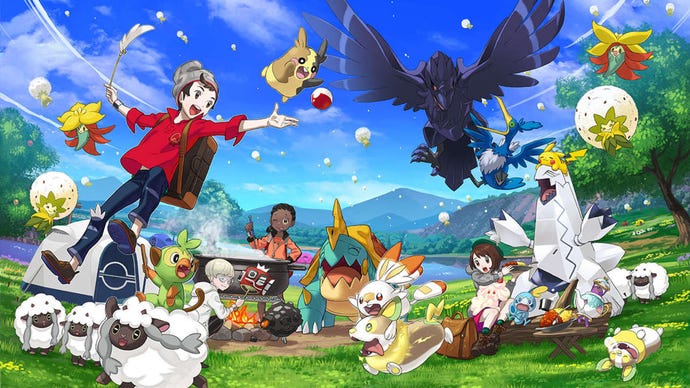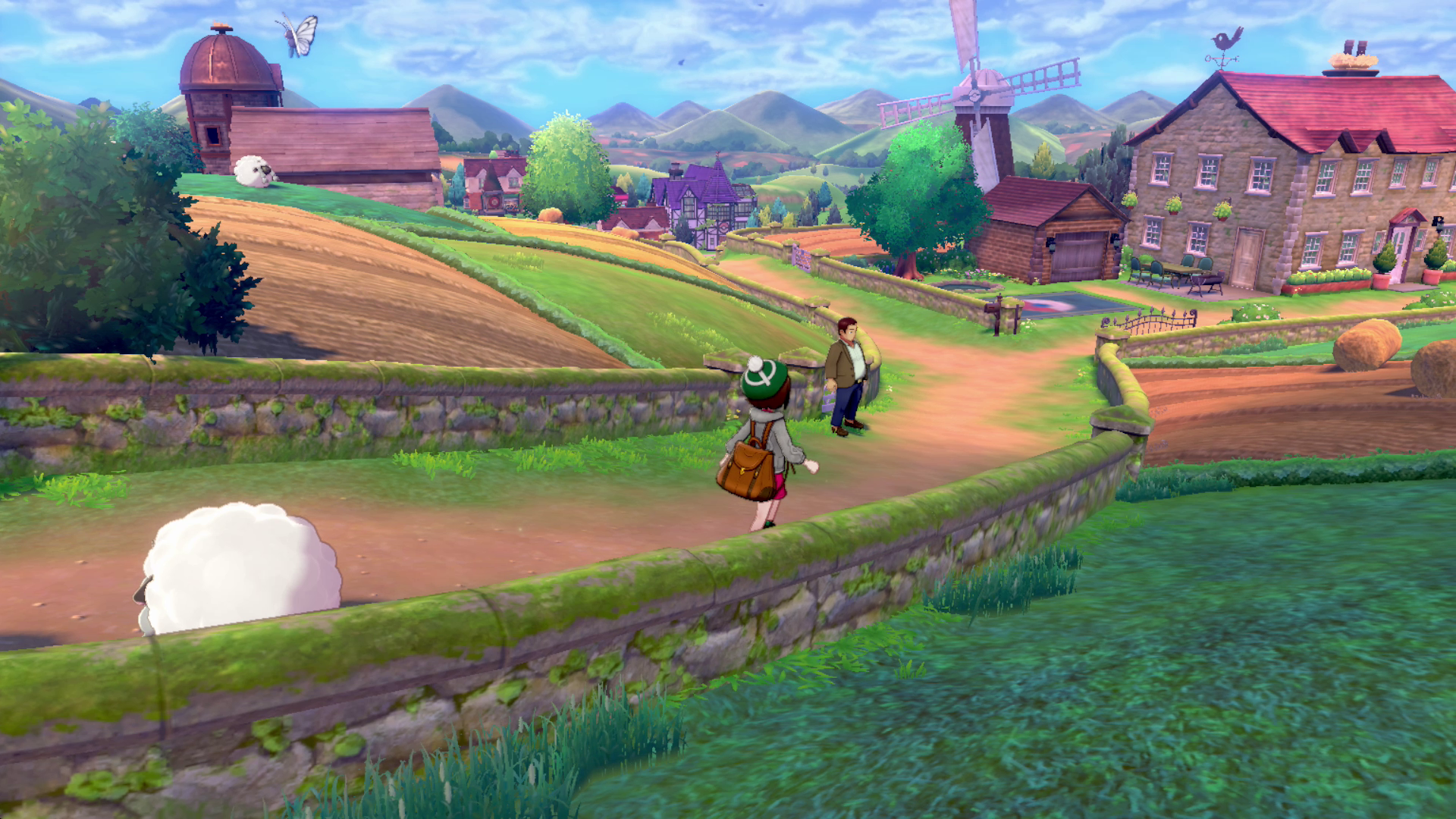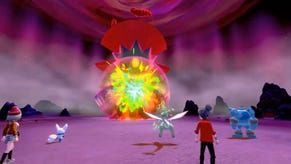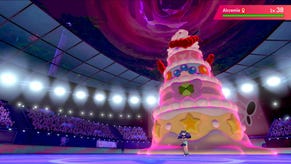Pokemon Sword & Shield review: ambitious in places, seemingly unfinished in others
In some ways, Pokemon Sword & Shield is the most ambitious Pokemon title ever. In other ways, it is a definitive step back. It's a strange game.
The promise of Pokemon Sword & Shield was always that it'd be a return to form. I really liked Pokemon Let's Go for what it was - a simplified, streamlined remake of a classic designed to work as a gateway for lapsed fans and Pokemon Go players. Many of the ideas expressed in that title deserve to be carried back to the main series, but there was understandably a hardcore element that was missing there. The promise was that the next games would remedy that. This is the strangest thing about Sword & Shield: after all those promises, I'm not really sure it does.
Anybody who has been paying the remotest amount of attention to the world of Pokemon in the last six months likely knows the biggest controversy: the lack of a 'national dex'. In the past, after completing the game players would be able to trade creatures over from previous games to bring in their favourites even if they aren't native to that game's setting. Here, the Pokemon that naturally appear in the Galar region are all you'll ever be able to play with. There's also been small cuts to move sets and mechanics when compared to the previous fully-fledged entry, Ultra Sun & Moon.
Some of your favourites will inevitably be missing. But, honestly, the lack of the national Pokedex is one issue - a lightning rod - but it doesn't define this game. One can actually understand why Game Freak would make the decision it did, in fact. There's much else, for good or ill, that's more important. Sword & Shield is a game split right down the middle - in one moment it seems vast, beautiful and impressive - but then a moment later it bafflingly disappoints in the same areas it just impressed.
Let's take Pokemon battles, for instance. This is still a game where battles take place on a discrete, separate screen after a transition, which is fine. Sometimes those battle scenes take place in gorgeous little dioramas that represent the areas you're in, with rolling hills and charming British-inspired architecture that really seems to take advantage of the Switch. The flip side is that many battles also take place in a sort of nightmare void - a patch of coloured ground with little to no other background detail.
Showdowns with gym leaders are the coolest they've been, taking place in stadiums where the camera cuts away to a roaring, chanting crowd as trainers animate with flair and exchange quips at key moments. It looks cool! It feels like you're part of a battle scene in the anime. On the way to the leader, however, every gym trainer battle takes place in another emotionless void. What should be an exciting build to an epic confrontation just... isn't. The bang is there at the finish - leader encounters are exciting and dynamaxing is a great gimmick - but the battles leading there fall flat in presentation.
This whiplash-inducing back-and-forth is everywhere. Some cutscenes look the best Pokemon ever has. Characters gesture, camera angles swish about - and then in others, canned animations play out in a way that looks a bit like a first draft, a version of the scene designed to set the camera blocking and little else. The game looks at its best in handheld mode, but there's no touch screen compatibility whatsoever - even though the big-buttoned user interface clearly looks ripe for it. In some cases, touches present in even the most recent game are just suddenly absent, like how there's a fast travel mechanic that replaces the traditional 'Fly' move which has no associated animation whatsoever. When you use it, the screen simply fades out and then back in at the new location. Previous games always had animation for a feature like this. It's strange.
This sort of thing leaves one wondering if the development team simply ran out of time; if there were plans for more bespoke battle backgrounds that got pushed aside as the realities of HD development became clear. Right the way throughout Sword & Shield there's a whiff of the struggles Japanese RPG developers had in the first HD console generation, with games lopped back in haphazard ways to get them out of the door. Pokemon developer Game Freak was shielded from this for a long time by its handheld status - but now, on Switch, the HD demon comes knocking. Basically, there's an air of Final Fantasy 13 about it all. Uh-oh.
And yet - and yet - this is one of the most lovely, charming Pokemon games ever made. The Galar region is up there as one of my all-time favourite Pokemon settings, and not just because I'm British. It's true that I find the Pokeverse representation of my country and culture particularly charming through bias, but it's also true that this is the best ever representation of such things in this series. If being on a more powerful machine has allowed anything, it's a more intricate level of detail and flair in the design of its world, especially in towns.
The journey you go on is still familiar. You play a young lad or lass from a sleepy town who wants to become a Pokemon trainer and then champion. This time around you have connections: your best friend's brother is the current champ. He sponsors both of you to join the gym challenge, which in Galar takes the form of a sports challenge. As previously mentioned, gym showdowns take place in huge arenas with screaming crowds in what is an obvious nod to the UK's sports-obsessed, team-tribal culture. Some cheers, delivered in written dialogue, clearly go along to well-known football chants.
You travel from town to town across this compressed version of the UK taking on the various gym leaders. As your fame grows, people will begin to recognize you and cheer you along in towns. Along the way you'll catch Pokemon, battle trainers and generally engage in some solid RPG action. Pokemon has always been awash with depth in battle, with the hardcore left to put critters under the microscope to determine numerous hidden values and stats - all of that is present here in full.
The biggest change to the structure is the Wild Area, which is Pokemon's first attempt at an open-ended environment. You're kicked into this zone early, and to my surprise it actually stretches a good chunk of the Galar region, winding around a few key towns. In terms of size think of the Wild Area as more like a GameCube-era Zelda Hyrule Field than Skyrim, but it hits all of the right notes and feels exciting to explore.
In the wild area, level 50 Pokemon will skulk around from the moment you first enter, ready and waiting to one-hit KO you . At any time the choice is yours: you can push on with the story and just run to the next town or you can stop to grind, explore or even chance your arm trying to catch particularly powerful Pokemon. In the late and end game, the wild area can be used to catch, train and refine your team for the endgame or competition against other players, and raid battles allow you to team up online against powerful Pokemon in a manner very similar to Pokemon Go's raids.
The wild area is a smart structural change, and even though new and unnecessary roadblocks are in place to stop you from somehow lucking out and catching a level 50 Pokemon too early in order to break the game, it still feels more open and explorative than any past title in the series. The only negative of the wild area is that it exposes how poor the pop-in and performance is. Performance is mixed throughout, but the wild area truly exposes Sword & Shield's deficiencies. When a tree suddenly appears from nowhere about eight feet in front of you, you can't be blamed for stopping and marveling that this is on the same machine as Breath of the Wild, Luigi's Mansion or even a solid port of Skyrim, all of which perform better.
You're encouraged to return to the wild area often and you actually should - the rewards for exploring or participating in raids are significant, and in terms of pacing it does appear that later you're expected to want to return there to kill some time - the final four gyms happen in very quick succession indeed otherwise. The wild area serves to pad out both the late game and the post-game, where the rewards there will be required for building competition-friendly teams. It's worth noting here that as a result of the focus on an open-ended area you can choose to ignore, on paper this game definitely has one of the shorter A-to-Z critical path stories in the series - but everything you can do in the wild area is offered in exchange.
There's endearing and diverse characters around every corner, a less annoying best mate rival than in Sun & Moon and an actual rival who you can feel some real animosity towards. One touch I liked is that throughout the game there's a bubbling undercurrent of a greater story - myths of kings and a world-ending threat that's sure to return - but you're actively told not to worry about it. It simmers away in the background while you, a kid, focus on something more important: your gym challenge. That feels well in keeping with Pokemon's child-like charm and joy.
That childish glee is Pokemon's ace in the hole. There is something irresistible about the formula of this series, even in a game where you absolutely cannot catch them all. There is something impossible not to love about how it presents its over-the-top characters and caricatured world, and even as favourites are missing-in-action, many of the new Pokemon and moves are instant classics. There's so much to love that I really hope this world gets a second chance in a more refined release - never has Pokemon's tradition of a third, definitive version of a generation felt more full of potential than here.
In truth, it feels like Nintendo and The Pokemon Company might be forced down that road as a mea culpa, as the already loud cries about the Pokedex are likely to soon be amplified further as the true nature of changes to things like TMs, move sets and catching are fully understood by the most hardcore fans. After promising a Pokemon experience that'd satisfy the hardcore, this game is in fact much like Let's Go - fine as a more chilled-out experience, which is how I played it, but likely more disappointing the deeper a Pokefan you are. Bizarrely, it's also somehow less polished than that spin-off, a game which was supposedly developed quickly to allow the team to get to grips with HD development.
Thus is the conundrum, the paradox. Pokemon Sword & Shield is all too often a bit disappointing, and in some places actually feels a little unfinished, but it also fully provides that warm, fuzzy feeling that one expects from the series. Crucially, even through frustration, never once did I think about putting it down, which is to its credit. It comes recommended almost for the Galar setting and new Pokemon alone, but with a long list of caveats indeed. With the level of fan hyperbole surrounding this release, that recommendation is worth repeating and underscoring - but this is not the revolution that was promised or hoped for, and some may prefer to wait for a sale or wait and see if an improved, definitive release is on the cards.
Version tested: Switch (primary), Switch Lite. A review copy was supplied by the publisher.













